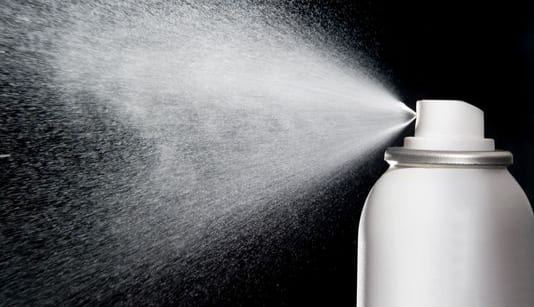By: Dena Berg-Castano, ACE
Canned aerosol insecticides are a staple in many pest management programs. The convenience of these ready-to-use products and the ability to apply and get the product into crevices and voids where pests live make them a go-to in the field. In addition to considering the ease of product application, it is important for a technician to review safety considerations of these products to ensure applications are not only effective, but also safe.
Canned aerosols use propellants to get the insecticide out of the can. This propellant can be flammable. The Safety Data Sheet outlines factors regarding flammability under sections: (2) Hazards Identification — where the flammable pictogram will be viewable and a description given; and (9) Physical and Chemical Properties — providing details on flashpoint and flammability range.
The flammability range provides a lower explosion limit (LEL) and an upper explosion limit (UEL) that define the concentration level in the atmosphere at which the product can be a fire or explosion hazard. If the concentration is too rich (or above the UEL), the product will not ignite. If the product concentration in the air is below the LEL, the product will not ignite. Although it may be difficult to determine the exact concentration in the atmosphere during application, it is correct to say the broader the range is between the LEL and UEL, the greater the chance of an ignition.
The product label also will provide direction on flammability under the Physical and Chemical Hazards section. Action statements are given to further explain what the applicator can do to increase safety.
A thorough inspection prior to beginning your application should include looking for the precautions noted on the specific product label and SDS you are considering using.
7 TIPS. Some tips for pest management professionals using canned aerosol products safely are:
- Read the Label and SDS to understand the actions you need to take to prevent unsafe applications.
- Do a thorough inspection to determine any hazards that will negatively affect your application.
- Do not over apply product. If you apply more product than advised per label, you can create a build-up of vapors that can ignite.
- Store product in a well-ventilated area, and keep it well secured to prevent potential puncturing of the can.
- Turn off all ignition sources like pilot lights. Open flames should be extinguished to prevent a flammable situation. Remember that static electricity is enough to cause a spark as well. (The Environmental Protection Agency recommends at least six feet from ignition sources for foggers.)
- Check surface area temperatures to ensure that they are below the flashpoint temperature range as listed on the SDS Section 9.
- Keep in mind that vapor drift can be a concern as treatment area temperatures increase. This can cause product to drift from one area to another where a pilot light may be burning, etc., thus creating a potential fire.
According to the California Department of Pesticide Regulation, aerosol-driven pesticides cause 500 fires and explosions in the United States annually. As with any pesticide application, the pest management industry needs to act responsibly with safety top of mind.
A thorough review of your product label and SDS, along with an inspection before beginning applications to identify environmental factors that could cause a flammable situation, are crucial to making decisions when selecting your pesticide product and application method.
Dena Berg-Castano, A.C.E., is a member of the Copesan Technical Committee and has 15 years of experience in the pest management industry. She holds a bachelor’s degree in education and currently serves as technical director of Northwest Exterminating, Tucson, Ariz.
This Tech Talk article was originally published in the August 2018 edition of PCT magazine.

